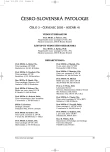Immunohistochemical Study of the Apoptotic and Proliferative Mechanisms in the Intestinal Mucosa During Coeliac Disease
Authors:
S. Lísová 1; J. Ehrmann 1; A. Kolek 2; E. Sedláková 1; Z. Kolář 1
Authors‘ workplace:
Ústav patologie LF UP a FN, Olomouc
1; Dětská klinika FN, Olomouc
2
Published in:
Čes.-slov. Patol., 41, 2005, No. 3, p. 85-93
Category:
Original Article
Overview
Mechanisms leading to morphological changes of the small intestine during coeliac disease are not yet completely recognized, however, two main processes have been suggested recently: remodelling of mucosa by matrix metalloproteinases, and mucosal atrophy by apoptosis. The aim of this study was to analyze the expression of proteins regulating apoptosis and some markers of proliferation in the mucosa of the small intestine of children with active (ACD) and latent form (LCD) of coeliac disease (CD). Intestinal biopsies of 43 children with ACD and LCD were analyzed by standard indirect immunohistochemical technique for Fas, Fas ligand (Fas-L), tissue transglutaminase (tTG), Bcl-2, Bid, glutathione S-transferase (GST), CAS 3, CAS 8, PARP, Ki-67, Topoisomerase IIa, PCNA expression. We found significantly lower numbers of Fas-expressing enterocytes in ACD patients than in LCD patients and controls. The number of Fas-positive mucosal lymphocytes was decreased in ACD when compared with LCD. Fas-L expression in enterocytes and mucosal lymphocytes was higher in ACD and LCD compared to controls.We found significantly more Bcl-2 negative lymphocytes in ACD than in LCD and controls. Bid expression in enterocytes was higher in LCD compared to ACD and controls. In intraepithelial lymphocytes, there was higher Bid expression in LCD than in ACD and controls compared to expression in mucosal lymphocytes, where was found higher number of positive cells in controls than in ACD and LCD. Expression of CAS 8 in mucosal lymphocytes was significantly higher in ACD compared to LCD. The expression of tTG in extracellular matrix and basal lamina was significantly higher in LCD and ACD when compared to controls. Expression of tTG was higher in the group of ACD and LCD in the enterocytes and in the lymphocytes. Our findings showed that Fas/Fas-L, Bcl-2, and CAS 8 may be involved in modulation of apoptosis during CD. Increased apoptotic elimination of IEL in LCD can partially explain preservation of the normal villous architecture. Increased tTG expression may be an early sign of increased apoptosis or may be related to its role in CD pathogenesis.
Key words:
coeliac disease – apoptosis- Fas/Fas-L – Cas 3,8 – PARP
Labels
Anatomical pathology Forensic medical examiner ToxicologyArticle was published in
Czecho-Slovak Pathology

2005 Issue 3
Most read in this issue
- Mammary gland development and cancer
- Emphysematous Cystitis due to Clostridium perfringens - a Localised Infection in a Man with Generalized Melanoma
- Adenomatoid Tumor of the Right Adrenal Gland: A Case Report
- Immunohistochemical Study of the Apoptotic and Proliferative Mechanisms in the Intestinal Mucosa During Coeliac Disease
